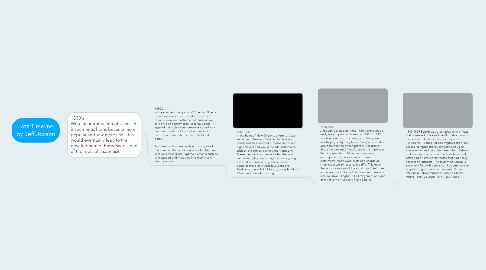
1. 1830's With the introduction of valves in instruments, horns became more popular and saw more use. This would eventually lead to the development of Brass Bands, one of the roots of Jazz music.
1.1. 1890's In the southern rural parts of America, Blues is born. Blues was a term used to describe a form of vocal and instrumental music as well as a style of performance. Jazz musicians applied this style of performance as well as a harmonic pattern of the 12-bar blues as a basis for improvisation commonly found in blues. Also around this time, a style of composed piano music started to flourish called Ragtime. Jazz musicians used Ragtime elements such as syncopation and melodies into their music improvisation.
1.1.1. 1900-1917 In the heart of New Orleans, a form of Jazz known as "Dixieland" started to develop. Bands usually consisted of between five and eight players and would include instruments such as the cornet, clarinet and trombone. These melodic instruments called the front line, would play contrasting melodies giving this kind of music a polyphonic texture. Some of these early Jazz musicians are Ferdinand "Jelly Roll" Morton, Joseph "King" Oliver and Louis Armstrong.
1.1.1.1. 1935-1945 Although developed in the 1920's swing music really rose in popularity around 1935 to 1945 which was know as the swing era. Swing was mostly played by "big bands" and consisted of about fourteen to fifteen players. Because of this, arrangement of music was more important than improvisation. Main melodies were accompanied by saxophones or brass instruments that played sustained chords or short repeated phrases called riffs. This gave the saxophone one of the most important roles in the swing era. Some fine Swing era musicians include Duke Ellington, Ella Fritzgerald, and one of my favorite musicians Frank Sinatra.
1.1.1.1.1. 1940-1955 Bebop was a complex style of Jazz that consisted of a small band of about four to six people. Like the earlier Jazz style of "Dixieland", Bebop utilized improvisation but utilized complex chords consisting of up to twelve notes and complex harmonies. Bebop melodies were varied and unpredictable and often had a flurry of fast notes that had heavy accents on offbeats. The rhythm of Bebop is extremely fast with percussion instruments also emphasizing offbeats with accents. Some influential Bebop musicians include Charlie Parker, Dizzy Gillespie, and Hank Jones.

